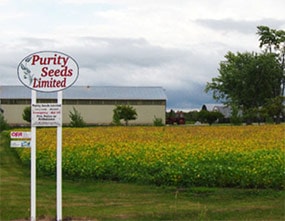
Testimonials
Godenir’s Testimonial
My name is Andrew Godenir. My dad, Rodney, and I own and operate Godenir Farms in Antler, SK. We started using OMEX products 6 years ago when we experienced hail damage on our canola. We had a good response and have since added it to our plan.
In the summer of 2021, we experienced 25 % hail damage on our beans. We contacted OMEX and with some excellent technical support and great customer service we were able to pick up and apply C3 and Super B to our crop within 16 hours of the hail storm. The crop showed a great response, and within 12 days showed intense re-growth. At harvest, the beans had come back with equal or better yields than the crop without damage. Without OMEX’s quick response times, our crop would have been a total loss.
As a farmer, customer service and technical support is number one in my mind. To be able to reach a rep to talk through a problem is super important. Rob is always available at a moment’s notice, and goes above and beyond to ensure we are serviced with products we need. I know that OMEX is a large company, but from a personal level, it does not feel like a large company, it feels like a “ma and pa shop.” OMEX guarantees that at the end of the day you feel heard. They are a team of people that truly care about the farm, and ensure that what is being sold to us, is what we really need to better our crop. I would highly recommend OMEX to any farm. If you aren’t using their products, you should definitely check them out. You won’t be disappointed.
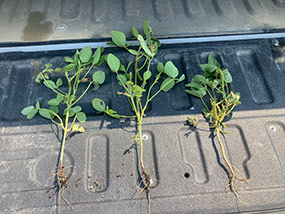
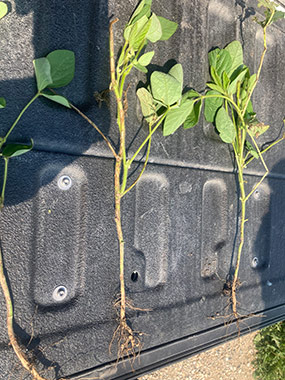
From Wes Arnfinson, Shur-gro Farm Services Ltd., Shoal Lake Manitoba
We have been selling the OMEX product, pHix, out of our Shoal Lake branch for eight years now. Before pHix came along, we would receive on average six glyphosate performance inquiries per year. The only problems we generally see with glyphosate nowadays are because of misuse — like rainfast or application too late in the day or too early in the day. It (pHix) has become a low-cost insurance for anyone spraying glyphosate.
I was always concerned with upping the water volume for coverage issues because the more water, the less desired results. I have attributed this to more pH antagonizing and hard water issues. There are about eight municipal wells in the trading area that growers pick up their water for spraying, and two of these wells are known to be extremely hard water (> 1000ppm hardness.) With the use of pHix, they can now use these wells.
For general pre-seed burn-off or in-crop RR spraying, we generally suggest a use rate of 500 milliliters per 100 gallons of water. For chem fallow, spraying out old hay land, preharvest or postharvest spraying, or anytime challenging weed issues arise, we have been suggesting one litre to every hundred gallons of water.
pHix is a product we can count on to achieve more satisfactory results.
From Larry Lamb, Purity Seeds, Emo Ontario
I entered a Soybean Yield Challenge in my area during the 2016 growing season. With agronomic advice throughout the season from, Trevor Thorton (Crop Care Consulting, Portage La Prairie MB) and Dr. Abdel El Hadrami from (OMEX Agriculture Inc., Oak Bluff, MB) I was able to obtain outstanding results. My soybean trial was weighed out by 3rd party personnel, and yielded an exceptional 59 bushels per acre; the next closest yield in the challenge was 40 bushels per acre. I would also like to mention OMEX Territory Manager Rob Hinton, was instrumental in making all this come together.
Environmental Conditions: Damp conditions throughout the growing season.
Here is what I did to obtain such high yielding soybeans:
- RR Richer Soybeans were used, seeded at 186,000 seeds per acre, with 18 inch row spacing.
- Treated RR Soybean Seed with Vibrance Max & OMEX Soybean Primer.
- RR Soybeans were inoculated with Nodulator Pro.
- The following macros were applied during seeding: N 22lbs, P 33lbs, K 51lbs, S 18lbs (Total pounds per acre of product).
- Sprayed one pass of Glysophate at recommended rate.
- Applied Soybooster ½ rate with 1 L per acre of Super B at flowering stage.
Here is what I saw:
By using Soybean Primer, Soybooster & Super B from OMEX, it definitely helped take my Soybean Yield Trial to the next level.
By applying Soybean Primer from OMEX, it enabled the Soybeans to get an explosive start & even plant stand early on.
By applying the Soybooster & Super B at the flowering stage, this fed the soybean plant at a critical time. This helped to fill the pods better and also helped the crop mature 4 days earlier than the untreated parts of the field.
With results like these, I will definitely use & promote OMEX Products in the future. With advancement in genetics and fine-tuned plant nutrition (ie: OMEX), I am confident that 100+ Bu/Acre Soybeans can be attainable in the future
From Steven Ganczari, Saskatchewan
I had about 3 acres worth of C3 left over from a pea field, so we sprayed it onto the barley until the tank was empty. This is a new field I rented that is sandy loam with a history of poor fertility.
I first used C3 in 2012 when I had a silage corn field turning orange due to excess moisture. My Richardson Pioneer rep said to use C3 when I sprayed the glyphosate on it. Turned out the best corn I ever grew. I have been using it every year on our land since; it works.
I could never grow corn like this without C3. I do have an agronomy background so I know how important nutrition is … especially at the 4 to 6 leaf stage.
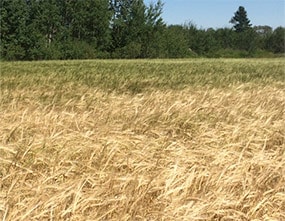
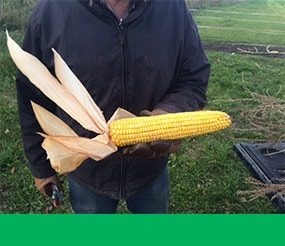
From Connie Matson and Bernie Hullman, Growers
I am proud of this field and am thankful for using OMEX Canola Primer on the seed and NutriBoost with the herbicide. This is the sixth crop for us on this previously neglected land.
The custom seeding equipment did not get here until May 19 – late in my eyes for canola. We seeded PIONEER 45H33 with applied OMEX Canola Primer on May 19, and were persistent in placing the seed only to the ½” depth. Seedlings emerged fairly quickly in the better areas of the field and were robust. A neighbor phoned a couple weeks ago, to tell me that neighbors are asking what we did here to get the crop emerging so fast under such dry conditions. One field across the road from ours was seeded on the same day, and is not even close in emergence or growth quality.
Rain History: 5/10 on May 16; 1/10 May 26; 1/10 May 31; 1/10 June 05; 3/10 in at south end to almost no rain at north end on June 11. Still very dry!
My husband Bernie, has no doubt as to using seed primer and the foliars. It is just part of our program.
Herbicide application June 15, and our custom operator wondered why I would add foliar, and risk spending more $$ when it is so dry. My answer was, to help the plant push harder under these conditions, and to recycle nutrients again for the next few days, while we wait for moisture. Our sidewalk has been barely damp 2 times this week, but at this point, we still believe that we made the right choice and to help decrease the risk of losing the crop! I hope he drives by to see how much the crop has cabbaged since application of herbicide and NutriBoost through sprayer on Monday! I also hope we get rain this weekend. At this point in time, I believe our canola has caught up to crops in this area that were seeded a week and 10 days prior to ours; all clubroot resistant, but different varieties. I believe this field has much more potential at this point, because of the OMEX Primer and NutriBoost. Shallow rooted crops must be close to starvation point, with no moisture, no nutrient uptake. We plan to apply Super B later, with or without fungicide (depends on the actual disease risk at the particular time.)
June 19 p.m. Update: Nice birthday present for Bernie: 4/10 rain! Crop is growing very hard with good leaf area index and we have managed to protect our investment and yield potential up to this point in time.
June 23, 2015: OMEX rep, TJ West and I looked at our canola crop at Wetaskiwin this a.m. We dug plants and compared to 2 neighboring crops, one on the east seeded a couple weeks ahead of ours, and one on the west seeded same day as ours. Our good areas are now closing in. After the glyphosate and NB last Monday, and the Friday rain, our plants have grown beyond expectation. Crop stage is very close to the field east (seeded earlier) and no comparison to the field west which was seeded same day as ours. The roots are amazing as the Primer drove the roots straight down – the neighbors canola roots in two adjacent fields both going sideways, and closer to the soil surface (where it would have been easier to feed on phosphorus early in the cold soil). There are more abundant roots here, and you can see the NB application and where the plant kicked into higher gear again. Huge white, active roots and lots of root hairs! Our field may not be the perfect picture and continues to be problematic, but at this point the good areas have very good yield potential, which I will take, over the neighbors best areas. We have new seedlings emerging in the dryer and problematic areas of the field. Two crops in one!
T.J. made a good point in that it would be ideal to apply ½ L of Boron now, as it will assist in cell division in the plant (prebolt), and then again going into 20-30% bloom (pollination).
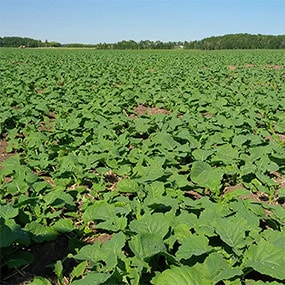
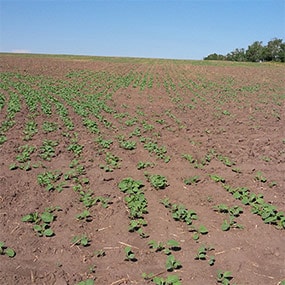
From Phillip Tschetter, Estuary Colony, Leader Saskatchewan
Like most producers we are wanting to produce the best crops we can and achieve the best yield we can. Improved farming practices and improved seed genetics has come a long way and we are increasing crop production however this increase comes at a cost and that cost is that we are mining our soils.
We work closely with our local crop input dealer who provides us with a well- balanced fertility program however I still felt we could do more so we started looking into micro’s and crop health products by Omex Agriculture. As growers and Stewarts of the land we need to start putting back so that future generations can continue to grow productive healthy crops.
We currently use the OMEX Primer Zinc, Primer canola and Pulse Primer. These are easy to use and are applied when we do our seed treatment. We also have used several of the Omex foliar products during the course of the year. The payback has been more consistent crops from year to year , even, earlier maturity and we are building a strong heathy foundation for future generations to plant and grow their crops.
From Hofer, Arm River Colony, Lumsden SK
This season we tried a product on 40 acres of yellow peas. The product was KinGro from OMEX along with OMEX’s SuperB (boron). We applied the KinGro at the recommended rates to 40 acres and added ½ a litre of the OMEX SuperB. We applied this right at flowering time. This crop had also seen a hit of hail around this time. We combined these peas on August 17/2015 and we were surprised to see a 10-12 bu per acre increase from the rest of the field which was sprayed with Proline only. In today’s market where the demand to feed the world is greater than ever, we think it’s important to work with companies like OMEX to help improve crop quality and yield.

